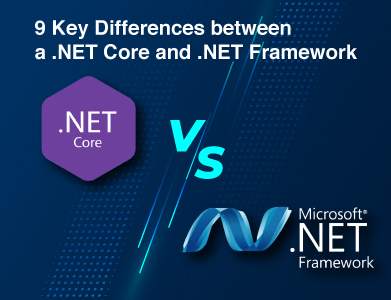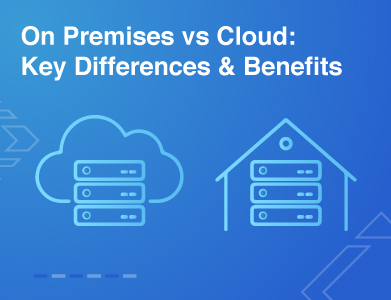Expertise
Enterprise systems tend to grow in all directions over time. You’re investing in digital tools, but your systems feel slow, hard to update, and costly to scale. Every small change takes weeks. The integrations are messy. Your tech team spends more time maintaining than improving.
And in the middle of all this, one big question keeps coming up: Is your software architecture helping or holding you back?
At some point, someone suggests “breaking things into services.” It sounds promising. But now you’re faced with two options: Service-Oriented Architecture (SOA) and Microservices.
Both are built on similar ideas, but they solve different problems, in different ways.
So, which one actually makes sense for your business?
That’s what this post is here to help you figure out.
What is SOA?
SOA, or Service-Oriented Architecture, is a way of building software where different parts of the system (called services) talk to each other through a central system.
Each service in SOA architecture does one job, handles a specific business function, and talks to other services through a standard interface. These services can live on different systems, be built in different languages, and still work together as one coherent setup.
For example, your billing system and your user login system might both use the same identity service. This setup makes it easier to reuse services across different teams or departments.
SOA works well when you have large systems, legacy software, or multiple teams that need to share data or functionality. But the downside is that it can get complex and slow over time, especially if the central system becomes a bottleneck.
What SOA is Good At
- Connecting older systems with newer ones
- Reusing business logic across multiple applications
- Keeping things organized with clear contracts between services
- Managing large-scale enterprise processes
But SOA often relies on centralized communication layers like an Enterprise Service Bus (ESB). That can be helpful for control, or it can become a challenge if not managed carefully.
Check out our full Guide to SOA Architecture for a detailed breakdown.
What are Microservices?
Microservices also break software into smaller parts, but each part runs on its own. These services are built, tested, and deployed independently.
Each microservice is small, focused, and runs on its own. Teams can build, deploy, scale, or even replace a microservice without affecting the rest of the system. It's like giving each piece of your application its own startup budget and letting it succeed or fail on its own.
This makes microservices faster to develop, easier to scale. Microservices are popular in cloud-first environments where agility matters more than centralized control, but they also need good coordination to avoid becoming too scattered or hard to manage.
What Microservices Do Well
- Support rapid, independent deployments
- Scale specific features based on demand
- Work well with CI/CD pipelines and DevOps practices
- Let teams use different tech stacks for different services
But with that freedom comes complexity. You’ll need proper logging, monitoring, and deployment automation. Without it, things get messy fast.
If you’re not sure between SOA and microservices, here’s a more practical take:
Pick SOA If:
- You have a lot of legacy systems you still rely on
- You need structured communication between departments or systems
- You want centralized governance and standardized processes
Pick Microservices If:
- You’re building new software from scratch
- You need frequent updates without downtime
- You have DevOps practices in place and like automation
The decision isn’t about which one is better in theory. It’s about which one fits your current environment and business goals.
SOA vs Microservices: Key Differences
| Feature | SOA Architecture | Microservices Architecture |
|---|---|---|
| Service Size | Medium to large services | Small, focused services |
| Communication | Centralized (often via ESB, SOAP, HTTP) | Direct (REST, gRPC, messaging queues) |
| Deployment | Services deployed together | Services deployed independently |
| Technology Stack | Shared across the system | Flexible; teams choose their own tools |
| Data Management | Often uses a shared database | Each service has its own database |
| Governance | Centralized control and policies | Decentralized; managed by individual teams |
| Service Coupling | Tighter coupling due to shared systems | Loosely coupled; services operate independently |
| Granularity | Broader, multi-task services | Narrow, single-function services |
| Scalability & Resilience | Harder to scale or isolate failures | Easy to scale and recover individual services |
| Best Suited For | Legacy systems, enterprise integration, compliance | Agile teams, cloud-native apps, frequent deployments |
While Service-Oriented Architecture (SOA) and microservices are both built around the idea of breaking down large systems into smaller, more manageable services, they take very different approaches in how those services are designed, built, and maintained. These differences directly impact scalability, team structure, development speed, and operational complexity.
1. Architecture Model
- SOA Architecture uses a centralized model. Services are built to be reused across applications and are often tied together through a core system, such as an Enterprise Service Bus (ESB). This central piece handles communication, security, logging, and more.
- Microservices Implementation favors a decentralized model. Each service runs independently, communicates directly or via lightweight messaging systems, and doesn’t rely on a shared controller. This allows for greater flexibility and removes single points of failure but shifts complexity to the edges.
Key takeaway: SOA provides stronger centralized control; microservices promote distributed independence.
2. Service Size and Scope
- SOA services are generally broader in functionality. A single service might support multiple business functions and be shared by various systems.
- Microservices are smaller by design. Each service focuses on one specific business capability—like handling orders, processing payments, or updating user profiles.
Key takeaway: SOA services are multi-purpose and reusable; microservices are narrowly focused and modular.
3. Service Granularity
- SOA leans toward coarse-grained services, meaning each service may handle multiple tasks or processes within a domain.
- Microservices are fine-grained. Each service is focused on one task, making it easier to scale, test, and change without affecting other parts of the system.
Key takeaway: Microservices offer more flexibility through finer-grained service boundaries.
4. Resource and Component Sharing
- SOA promotes shared use of components, libraries, and services across applications to avoid duplication and improve consistency.
- Microservices avoid shared components. Each service has its own dependencies, allowing teams to work independently without worrying about conflicts or version mismatches.
Key takeaway: SOA encourages reuse, which can introduce dependencies; microservices prioritize autonomy, which improves isolation.
5. Data and Storage
- SOA services often access a shared database or central data store. While this makes integration easier, it can lead to tight coupling and data conflicts.
- Microservices follow a “database per service” model. Each service owns and manages its own data, which improves independence and fault isolation but makes consistency across systems harder to maintain.
Key takeaway: SOA simplifies data coordination; microservices improve data ownership but increase data management complexity.
6. Governance and Control
- SOA typically involves centralized governance. Teams follow organization-wide rules for building, securing, and deploying services, which ensures standardization but slows decision-making.
- Microservices operate under decentralized governance. Individual teams have more freedom in how they build and run their services, enabling faster iteration but requiring coordination to maintain system health.
Key takeaway: SOA gives centralized control; microservices empower teams with autonomy.
7. Communication Between Services
- SOA usually relies on formal, standard-based communication protocols like SOAP and XML, which are designed for stability and consistency, especially in complex enterprise systems.
- Microservices use lightweight protocols like REST, JSON, or messaging queues (Kafka, RabbitMQ, etc.), enabling faster, more flexible communication and often supporting asynchronous messaging for improved performance.
Key takeaway: SOA favors structured, standardized communication; microservices prioritize speed and simplicity.
8. Coupling and Dependencies
- SOA aims for loose coupling but often ends up with more interdependencies due to shared databases, shared components, and centralized control systems.
- Microservices are built for minimal coupling. Teams avoid shared resources and connect services via APIs to keep things as independent as possible.
Key takeaway: Microservices achieve stronger service isolation, improving resilience and ease of change.
9. Deployment and Release Cycles
- SOA services are commonly deployed in large batches or bundled into enterprise applications. This means updates to one service might require retesting and redeploying the entire system.
- Microservices are designed for independent deployment. Each service can be developed, tested, and released on its own schedule using containers and automation tools like Kubernetes.
Key takeaway: Microservices support faster, more frequent releases; SOA offers consistency but slower change cycles.
10. Use of Remote or Third-Party Services
- SOA often integrates with remote services via the central ESB or middleware layer, adding more touchpoints for potential delays or failures.
- Microservices can also use remote services but are better prepared to handle them through built-in redundancy and fault-tolerance strategies like retries, circuit breakers, and fallback logic.
Key takeaway: Both architectures support remote services, but microservices are generally more resilient in handling them.
Use case: Mixing Old with New
A manufacturing company had a decade-old ERP system and wanted to launch a mobile app for field technicians. Rewriting everything wasn’t realistic.
They used SOA to expose core ERP functions like inventory and scheduling as services. Then, a few microservices were built to handle the mobile experience, pushing updates independently and scaling as usage grew.
And it worked. Legacy stayed where it was useful, and innovation moved at its own pace.
How Do You Choose?
The right choice depends on your business model, team structure, existing systems, and long-term goals.
Here’s a detailed guide to help you make an informed choice.
| ✅ Choose SOA if | ✅ Choose Microservices if |
|---|---|
| You have existing legacy systems to integrate | You’re building a new app from scratch |
| You need strong interoperability and shared resources | You want to move fast and deploy frequently |
| You prefer centralized management and standardization | You have a DevOps culture with containerized environments |
| You're building enterprise-scale systems with complex workflows | You need independent scaling for different components |
✅ Choose SOA If...
You’re integrating with Legacy Systems
SOA is well-suited for environments where older systems need to connect with newer applications. Its centralized design and standardized communication make it easier to bridge the gap between platforms built in different eras.
Use case example: Large financial institutions or government bodies that rely on mainframes or early enterprise systems often adopt SOA to modernize without replacing core infrastructure.
Your Goal is Reuse and Consistency across Departments
SOA encourages shared services across teams and systems. If your goal is to reduce duplication and ensure consistent processes enterprise-wide, SOA supports that with a centralized architecture.
Use case example: Organizations with shared HR, finance, or identity management services across multiple business units benefit from this model.
You need Strong Governance and Compliance
For highly regulated industries like healthcare, insurance, or public services, SOA allows for centralized control over how services are developed, secured, and monitored. This can reduce risk and ensure alignment with compliance standards.
Use case example: Enterprises managing customer data across regions with different compliance laws may prefer SOA to enforce rules consistently.
You have fewer, Larger Development Teams
If your teams are used to working in a centralized way with common tools and shared deployment processes, SOA can align better with how they already operate.
✅ Choose Microservices If...
You need Speed and Agility
Microservices allow you to release updates more frequently, fix bugs faster, and adapt to market needs with shorter development cycles. If speed to market is a top priority, microservices give your teams the flexibility to move fast.
Use case example: Ecommerce platforms or SaaS businesses launching features weekly or monthly often rely on microservices to support fast change.
You’re Scaling Rapidly or Building for the Cloud
If your customer base is growing fast, or your application needs to handle spikes in traffic (like during seasonal sales or events), microservices offer better scalability. They also fit naturally with modern cloud infrastructure and DevOps practices.
Use case example: Startups and digital platforms serving global users often choose microservices for elastic scaling.
Your Teams are Cross-functional and Autonomous
Microservices work best when small, independent teams own specific services end-to-end — from development to deployment. This model works well in companies that support decentralized decision-making and agile practices.
Use case example: Product-led tech companies where each team owns a feature or business capability often benefit from microservices.
You want to Reduce System-wide Risk
Because microservices are independent, a failure in one service doesn’t bring down the entire system. This architecture supports better fault tolerance and allows for targeted rollbacks or updates without system-wide disruption.
Still Not Sure? Consider a Hybrid Approach
Many organizations don’t need to choose one over the other. It’s common to use SOA for core internal systems (like billing or compliance services) and microservices for external-facing or fast-moving applications (like mobile apps or APIs).
Start small:
- Choose a business area where agility matters most.
- Build a pilot using microservices.
- Keep core systems stable using SOA principles.
This lets you modernize gradually while minimizing risk.
Is Microservices Just a Better Version of SOA?
Not exactly.
Microservices grew from the same ideas as SOA but were built for newer challenges. They offer more flexibility and speed, but they also require more planning around how services talk to each other and how teams manage them.
In some cases, companies use both. For example, SOA can manage shared internal systems, while microservices power customer-facing apps that change more often.
So no, microservices aren’t a “better version” of SOA. They’re just different—and better suited to different kinds of problems.
Final Thoughts
Both SOA architecture and microservices development are proven strategies. The question is: what are you trying to solve?
If you're dealing with legacy complexity, SOA might save you from unnecessary reinvention. If you're building something new and need to move fast, microservices give you that freedom.
Either way, breaking things into services is a smart move. Just make sure you’re picking the right flavor for your team and your goals.










